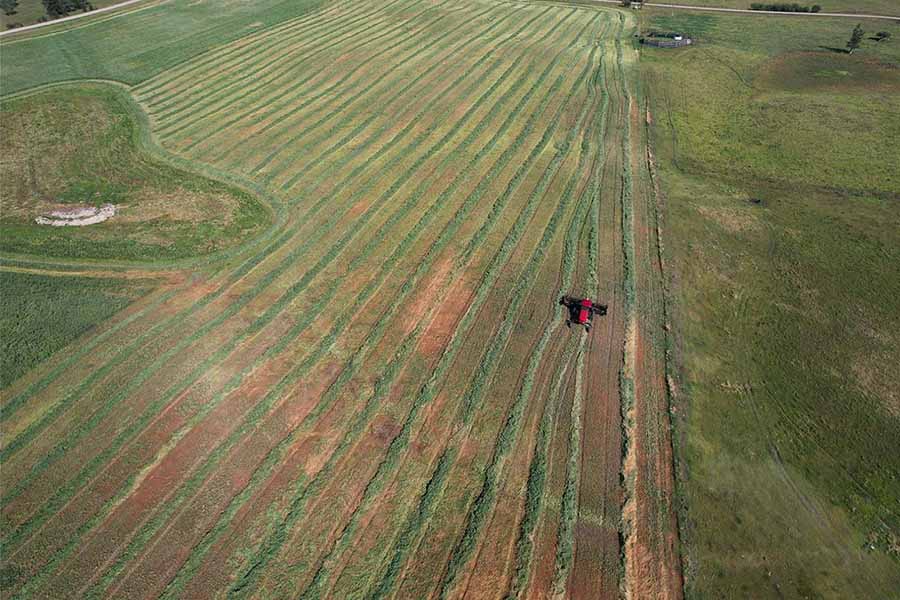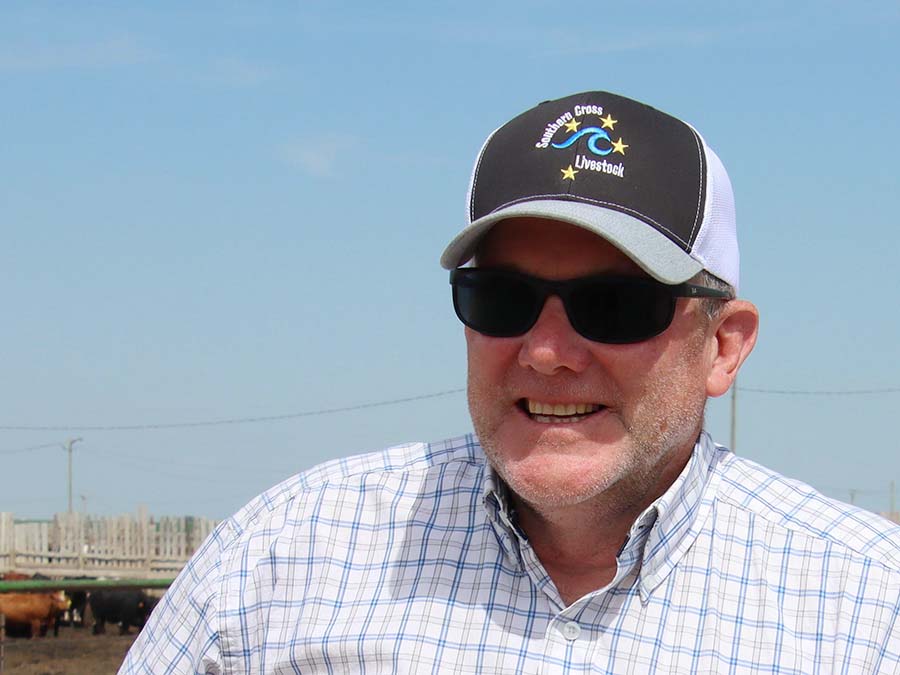 Aerial view of forage windrows slashed and ready for swath grazing.
Aerial view of forage windrows slashed and ready for swath grazing.
The primary area in which he could see opportunity for improved cost efficiency was during winter months when, traditionally, Canadian ranchers manually bring in straw for bedding, hay or silage for supplements.
Rather than spend significant money on tractors, fuel and imported fodder in winter, Graeme wanted to see if the cattle could graze year round, reducing labour and financial requirements. To achieve that, cattle need appropriate nutrition, energy to keep warm and protein to keep them growing.
Through workshops, Graeme learnt about swath grazing where, prior to winter, ranchers cut the grown crop of oats and lay it down, before snow snap freezes it in a condition cattle can continue to eat over subsequent months. Swath grazing has the potential to significantly lower winter feeding costs, cutting out the need to store and supply forage daily.
Increasing the total digestible nutrients (TDN) and protein of the forage was essential, and Graeme experimented with annual legumes and other crops to increase the nutrients per hectare.
Turning to New Zealand for examples, Graeme started working with PGG Seeds, who would export to Canada. He started blending Winfred forage rape seed into mixes of oats, triticale and peas, which moved nutrient rates from 9.3% protein to around 15.5% protein. With no manual on what ratio to make seed mixes, it was trial and error to figure out what percentages worked to create a good mix of forage.
 An example of Graeme's high protein multi-species forage cover crop.
An example of Graeme's high protein multi-species forage cover crop.
For summer, Graeme likes to seed a heavy mixture of different legumes, including alfalfa, cicer milk vetch and Glenview sainfoin along with the grass. The winter swath grazing evolved into now using a nutrient dense blend of forage rape, turnips, peas, sunflower, grains like triticale, and oats.
To control the daily feed intake of cattle, Graeme uses electric fences, and grazing paddocks are divided up into cells for cattle to be rotated through. Rotational grazing like this was all but unheard of in Canada when Graeme started, but it has since grown in popularity.
To measure efficiency, he looked not only at the increased nutrients in the forage, but at grazing days per hectare. At first, the average Graeme measured was around 1.5-2 acres (0.6-0.8 hectares) per animal to last around 170-175 days, but he quickly cut the figures down to only needing 1 acre (0.4) hectares per head to last 170-175 days, depending on the year's rainfall.
Bettering genetics was also a key component for improvement, and the breed of cattle was chosen based on preferred characteristics. He settled on Black Angus/Hereford as a hardy crossbreed; black coats to help keep livestock warm as well as good mothering properties from the Herefords.
For the right genetics, Graeme had to whittle down where he bought bulls, finding most Canadian ranchers gave bulls easier conditions over winter, with straw bedding and a high protein diet. The conditions in which they were kept meant they didn't cope well when turned out with the herd, which also, in turn, led to softer calves - something that wasn't ideal for herds that graze year round.
Another area where Graeme chose to reject Canadian tradition was with calving season, and therefore, when the bulls were put over cows. A large percentage of Canadian ranchers have their cows calve in February and March, assuming the calves will be in a good weight grade by the annual November sales. The final 6 to 8 weeks of winter can be harsh on the newborn calves and are high maintenance for ranchers. By pushing the calving season back from February/March to May, the calves have a better chance of survival in the warmer temperatures. By pushing back calving he has reduced both stress on cows as well as labour requirements for livestock management in bad weather.
With the addition of a high energy and protein diet from forage improvement, Graeme counteracts the extra months of life with faster growth in better conditions.
It's not only on-farm that Graeme works to ensure cost efficiency. Rather than rely on sending cattle to the sale yards, where prices are set by auction, Graeme sources his own buyers. He's found that working with his buyers, he's able to supply cattle to their demands, and as a result, on average makes around 10 cents a pound higher than the best sale of the week. The calves are weaned in November at around 580 pounds (263 kilograms) average.






